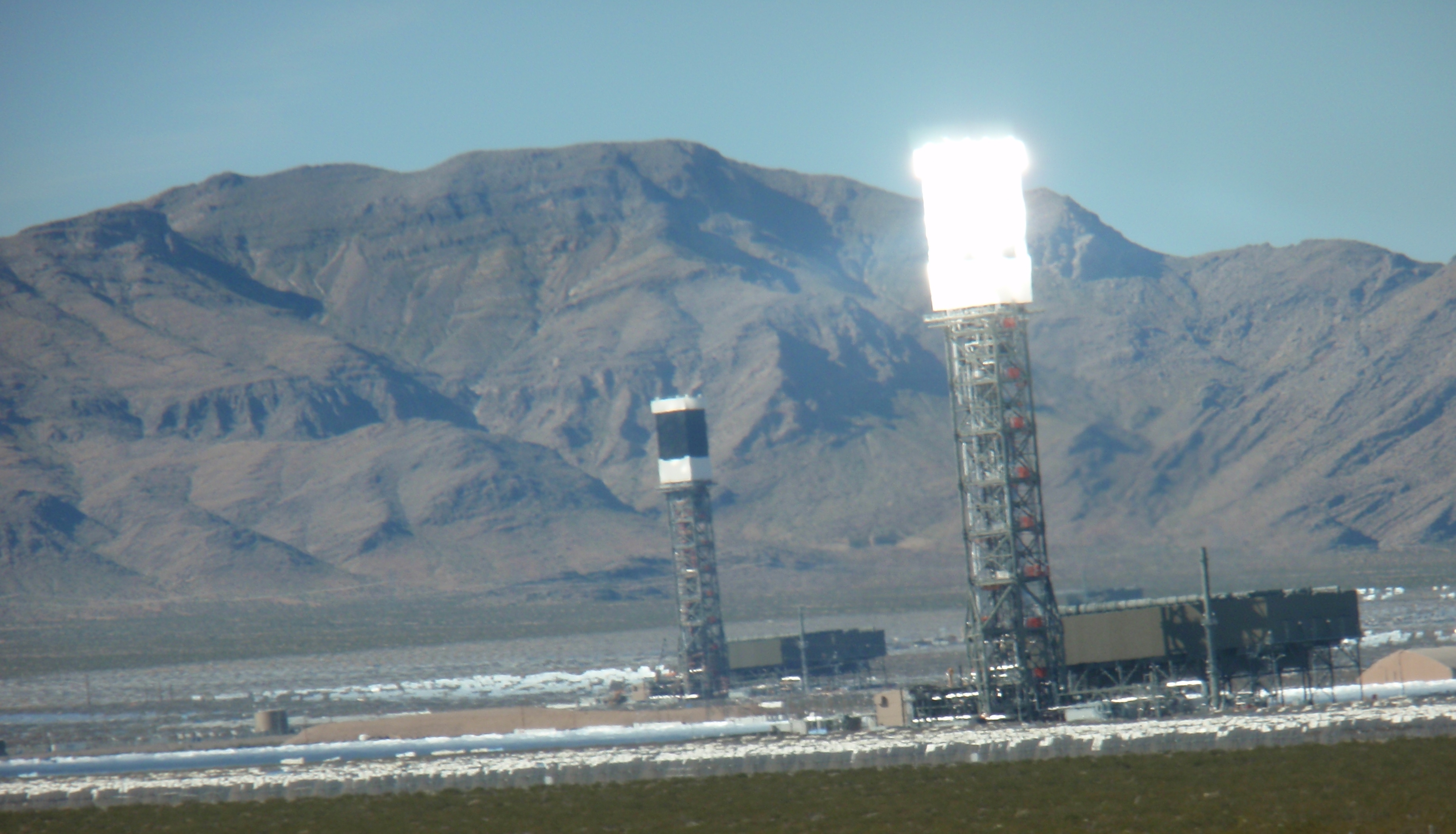(photo by James Ulvog)
Answer: Birds that fly into the solar flux at the top of the solar collector and ignite, producing a trail of smoke as they fall to the ground. Thus, a streamer.
That is the word used by the people who work at the Ivanpah solar facility, according to an article at ReWire by Chris Clarke: Federal Lab Offers Grim Look at Solar Harm to Wildlife. The article summarizes a few pieces of information from a report from a lab of the U.S. Fish and Wildlife Service. You can read the report for yourself here.
Do you suppose it is a bad sign that people working at a solar farm have a special word to casually describe birds that fall out of the sky after being toasted?
I picture movies about World War II in the air over Europe. Remember those views of an armada of bombers? One of the lumbering B-17s takes a flak burst, starts streaming smoke from an engine on fire, and slowly spirals into the ground. A streamer.
While staff from the FWS Office of Law Enforcement department were on site they saw a “streamer event” every 2 minutes. That could be dust particles or it could be a cloud of insects, as claimed by the staff who work at the facility. OLE did observe birds (plural) fly into the solar flux and incinerate.
Perhaps the California regulators ought to know how many of those thirty incidents per hour are birds and how many are humongous clouds of concentrated dust drifting hundreds of feet in the air before they issue any more wing-toaster permits.
Undercounts of birds and no counts of butterflies
The report also describes a reason the official reported mortalities are undercounted. The visiting staff observed a raptor of some sort, possibly a falcon, fly into the solar flux under normal flight control, show a visible stream of smoke from its tail upon leaving the solar flux, and have an unstable, quick, yet controlled descent to the ground. The bird landed beyond the facility’s perimeter and therefore is not counted in the avian mortalities.
Larger birds are possibly able to survive the immediate solar flux damage and fly beyond the perimeter before their injuries overtake them.
Picture those WWII bombers that took a hit. Some lost speed, dropping out of the formation, slowly descending, never to return home.
Mr. Clarke is concerned this report suggests that the avian mortality is higher than officially reported. Sounds like a serious concern for a variety of reasons.
The report also says there were many hundreds of butterfly and dragonfly carcasses on the ground, including large numbers of Monarch butterflies. So we can add large volumes of butterflies to the cost of solar energy.
Death trap
Mr. Clarke says the report reinforces his fears of an environmental death trap.
Large numbers of insects were noticed flying into the solar flux, presumably because it is far brighter than the surrounding area, thus drawing their attention. Those insects and butterflies and dragonflys draw birds that are hurt or killed by the solar flux as they hunt amidst the easy catch of a large swarms of bugs. Those birds not killed immediately still fall to the ground along with the dead ones. The injured birds are then not able to escape the predatory coyotes, ravens, and kit foxes that are looking for their lunch. If coyotes, ravens and foxes find easy meals, I’m guessing they’ll be back for more.
Thus, a death trap for a large part of the desert ecosystem.
Conclusion
The article cites the report which says 47 of 141 carcasses from Ivanpah showed signs the birds were damaged by the solar flux. From a cursory read of the report, I learned the analysts weren’t able to determine the cause of death for many birds because of decomposition. Thus, we can say at least 47 of the 141 birds were toasted.
If you have a strong stomach for viewing dead birds and charred wings, you can see 10 photos of damage in the report. I’ll describe some later.
The report analyzes bird deaths from the three large solar facilities in the California desert, which cover the three main types of solar technologies currently is use:
- Ivanpah Solar Electric Generating Station – concentrating solar towers – 392MW
- Desert Sunlight – photovoltaic solar – 550MW
- Genesis Solar – parabolic trough concentration solar – 250MW
I have a copy of the FWS report and will try to have another report later today.

One thought on “Question: What are “streamers” at a wing-toasting solar facility? (solar #19)”